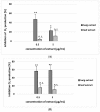Anti-Platelet Properties of Phenolic Extracts from the Leaves and Twigs of Elaeagnus rhamnoides (L.) A. Nelson
- PMID: 31597284
- PMCID: PMC6803833
- DOI: 10.3390/molecules24193620
Anti-Platelet Properties of Phenolic Extracts from the Leaves and Twigs of Elaeagnus rhamnoides (L.) A. Nelson
Abstract
Sea buckthorn (Elaeagnus rhamnoides (L.) A. Nelson) is a small tree or bush. It belongs to the Elaeagnaceae family, and has been used for many years in traditional medicine in both Europe and Asia. However, there is no data on the effect of sea buckthorn leaves and twigs on the properties of blood platelets. The aim of the study was to analyze the biological activity of phenolic extracts from leaves and twigs of sea buckthorn in blood platelets in vitro. Two sets of extracts were used: (1) phenolic compounds from twigs and (2) phenolic compounds from leaves. Their biological effects on human blood platelets were studied by blood platelet adhesion, platelet aggregation, arachidonic acid metabolism and the generation of superoxide anion. Cytotoxicity was also evaluated against platelets. The action of extracts from sea buckthorn twigs and leaves was compared to activities of the phenolic extract (a commercial product from the berries of Aronia melanocarpa (Aronox®) with antioxidative and antiplatelet properties. This study is the first to demonstrate that extracts from sea buckthorn leaves and twigs are a source of bioactive compounds which may be used for the prophylaxis and treatment of cardiovascular pathologies associated with blood platelet hyperactivity. Both leaf and twig extracts were found to display anti-platelet activity in vitro. Moreover, the twig extract (rich in proanthocyanidins) displayed better anti-platelet potential than the leaf extract or aronia extract.
Keywords: E. rhamnoides; adhesion; aggregation; antiplatelet activity; blood platelets.
Conflict of interest statement
We wish to confirm that there are no known conflicts of interest associated with this publication and there has been no significant financial support for this work that could have influenced its outcome.
Figures









References
-
- Wang H., Naghavi M., Allen C., Barber R.M., Bhutta Z.A., Carter A., Casey D.C., Charlson F.J., Chen A.Z., Coates M.M. Global, regional, and national life expectancy, all-cause mortality, and cause-specific mortality for 249 causes of death, 1980–2015: A systematic analysis for the Global Burden of Disease Study 2015. Lancet. 2016;388:1459–1544. doi: 10.1016/S0140-6736(16)31012-1. - DOI - PMC - PubMed
MeSH terms
Substances
Grants and funding
LinkOut - more resources
Full Text Sources
Medical

